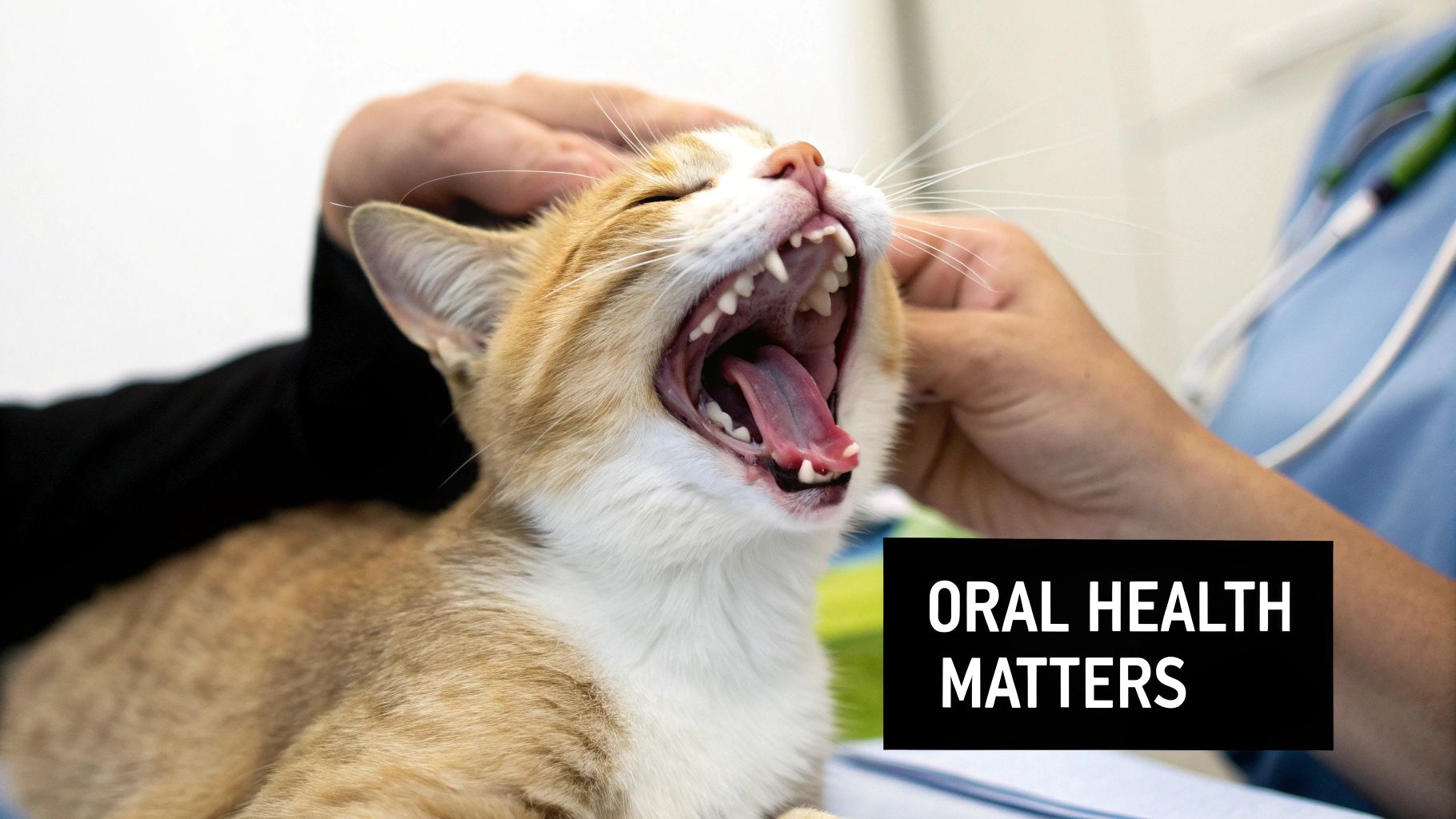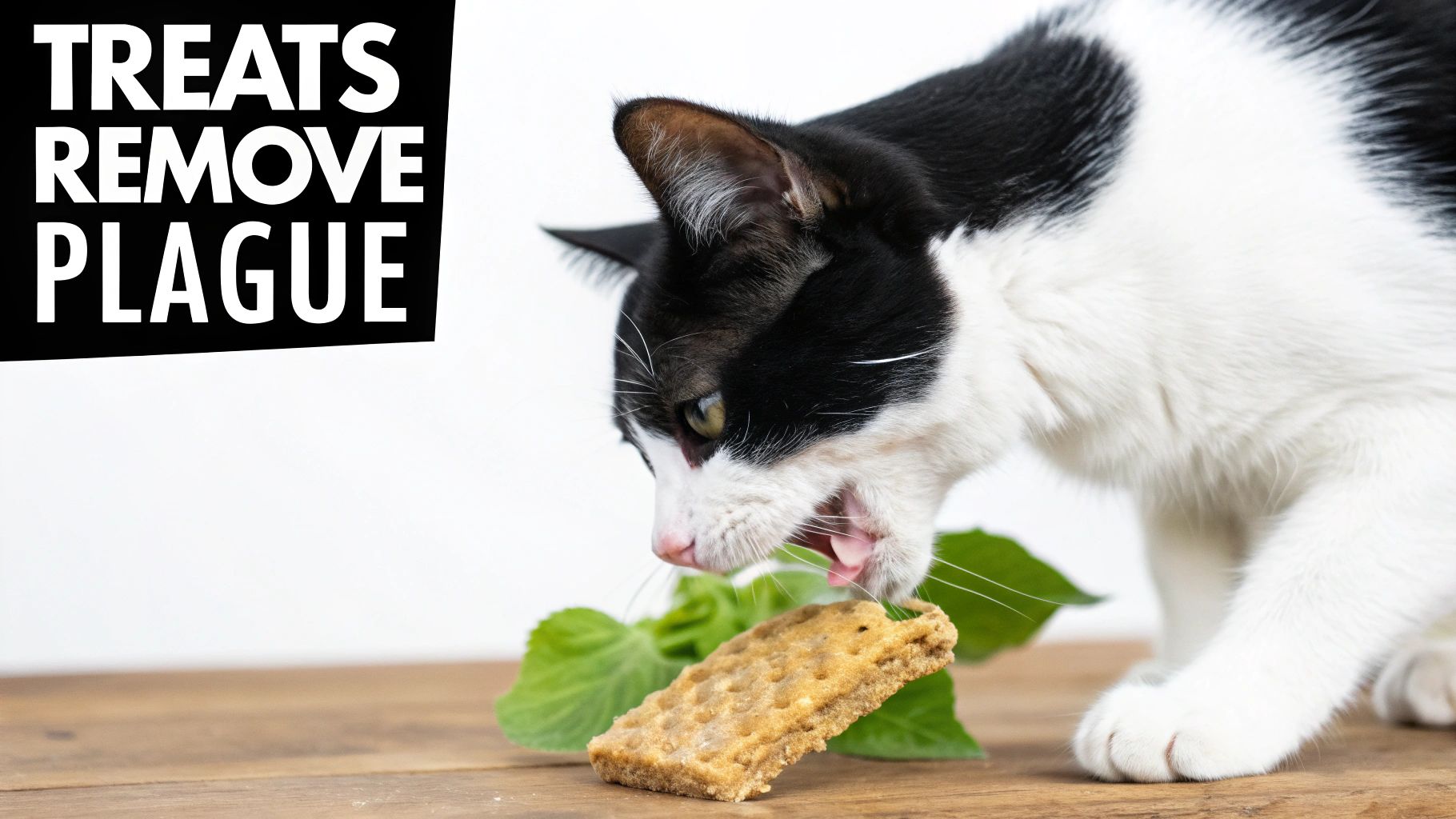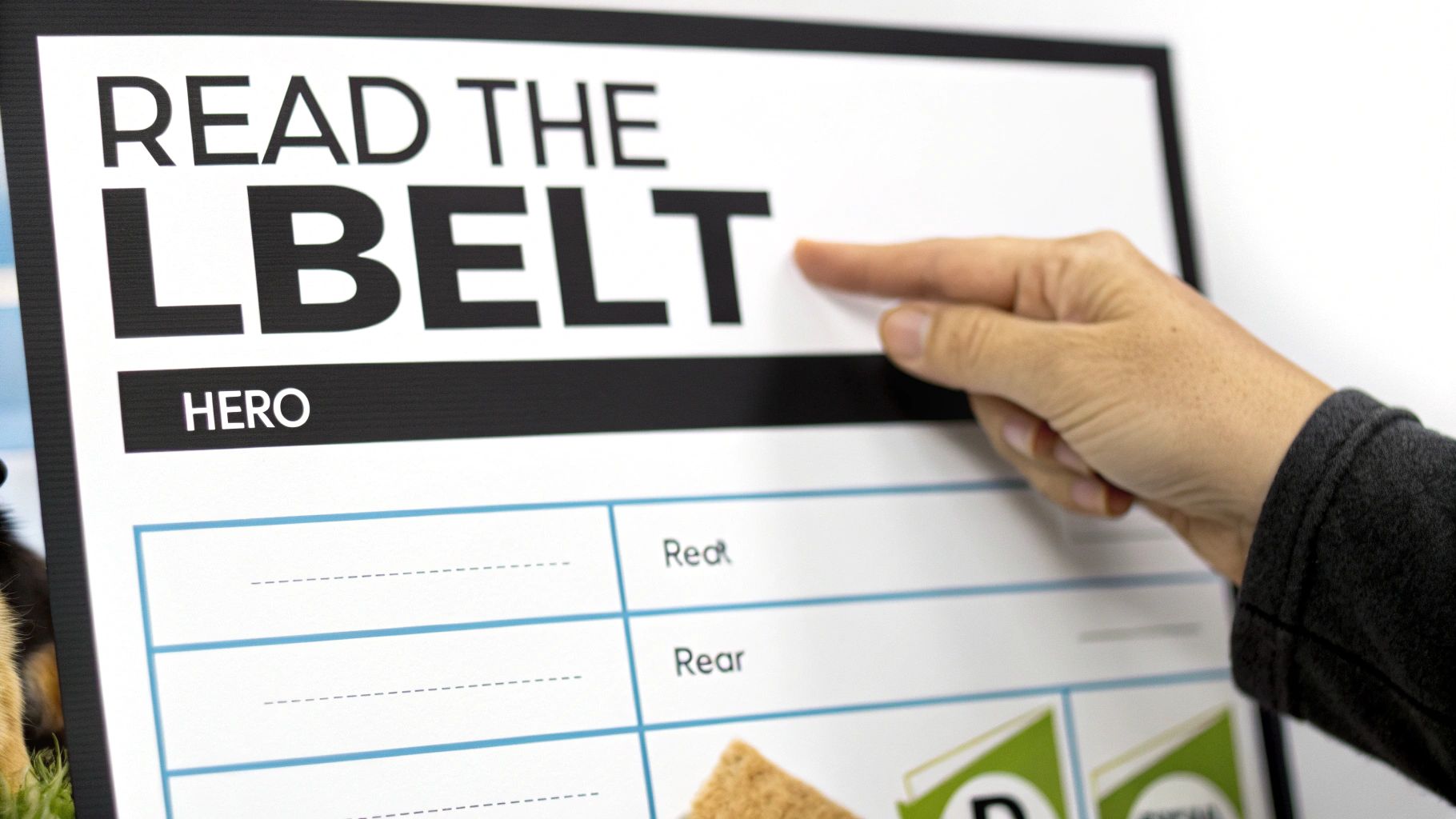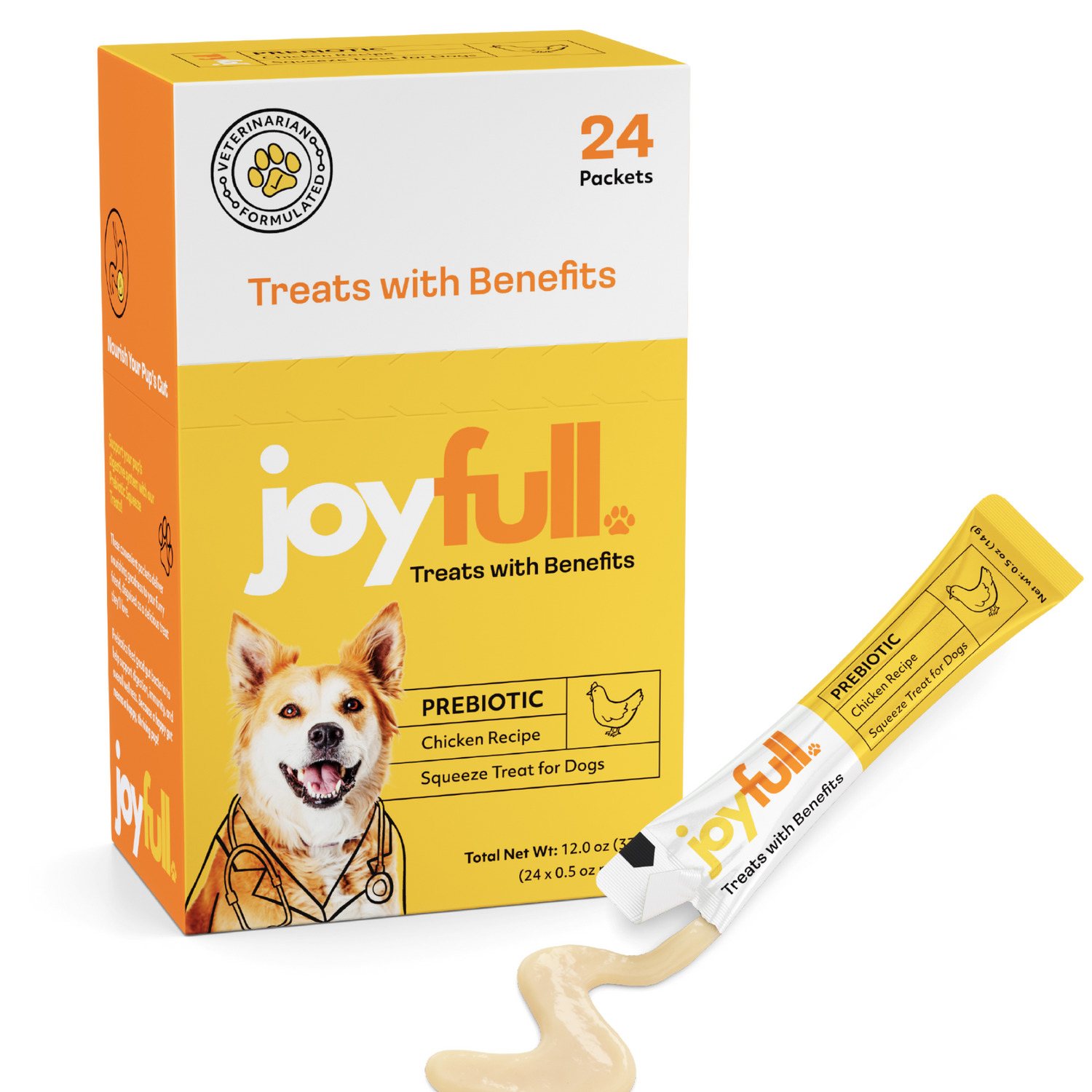
Cat Treats for Dental Health: Do They Actually Work?
That fishy odor on your cat’s breath might seem like a small thing, maybe even a little quirky. But more often than not, it's the first hint of trouble brewing inside their mouth. This isn't just about bad breath; poor oral hygiene can snowball into serious health problems for your cat.
Thankfully, there's a simple and effective way to step in. Cat treats for dental health are a fantastic tool to help you manage your furry friend's oral care between professional cleanings.
More Than Just Bad Breath: The Real Dangers of Poor Dental Health

It’s easy to let your cat's dental hygiene slip your mind. After all, they’re not exactly asking for a toothbrush. But what begins as a bit of harmless plaque can quickly escalate into something much more serious.
Think of plaque as a sticky, invisible film of bacteria that’s always building up on your cat's teeth. If it isn't cleaned away, it hardens into tartar. This hard, yellow-brown deposit irritates the gums, causing inflammation known as gingivitis—the first stage of periodontal disease.
That persistent bad breath you've noticed? It's one of the most common early warning signs. You can learn more about the different reasons for this in our guide on what causes bad breath in cats.
How Oral Health Impacts Their Whole Body
The problem doesn't stop at the gumline. Bacteria from an infected mouth can easily hitch a ride into your cat's bloodstream. From there, it can travel to vital organs, potentially causing or worsening serious conditions affecting the heart, liver, and kidneys.
This makes staying on top of dental care a critical piece of their overall health puzzle.
The numbers are pretty staggering. Industry data shows that periodontal disease affects roughly 70% of cats by the time they're three years old. It's a clear sign that these issues start much earlier than most people realize.
A Growing Awareness of Feline Dental Care
This isn't a niche problem, and the pet care world has taken notice. The global pet dental health market is valued at $8.25 billion, and products specifically for cats make up a huge and expanding piece of that pie.
With the market expected to climb to $12.70 billion by 2030, it’s clear that cat owners are looking for practical, effective solutions—and dental treats are at the top of the list.
Let's be honest, trying to brush a cat's teeth every day can be a real struggle. That's where dental treats come in. They aren't just a tasty reward; they’re specially designed to help scrub away plaque with every bite, supporting a longer, healthier, and happier life for your companion.
How Dental Treats Clean Your Cat's Teeth

It’s fair to ask: can a little snack really clean my cat's teeth? The answer is a surprising yes. Quality cat treats for dental health aren't just tasty bites; they're designed with a specific job in mind.
They tackle plaque and tartar in two clever ways, using both a physical scrubbing action and special ingredients that work behind the scenes. This one-two punch turns your cat's instinct to chew into a mini cleaning session.
The Mechanical Scrubbing Action
The most straightforward way these treats work is by physically cleaning the teeth. Think of their texture as a kind of edible, crunchy toothbrush. Unlike regular kibble, dental treats often have a porous, airy, or fibrous structure.
When your cat sinks their teeth into one, that unique texture scrapes against the tooth surface. This friction is what helps scrub away the soft, sticky plaque that builds up every day. It’s this mechanical cleaning that disrupts plaque before it can harden into tartar, which is much tougher to remove.
A treat's effectiveness really hinges on its shape and texture. The best ones are designed to make cats chew with their back molars—the teeth most likely to collect tartar—giving them a much more thorough clean.
By physically scraping off leftover food bits and plaque, these treats are your first line of defense for cleaner teeth and healthier gums.
The Chemical Cleaning Power
On top of the physical scrubbing, many of the best dental treats also have a chemical strategy. They include active ingredients that go to work on a microscopic level, making it harder for plaque and tartar to form in the first place.
Essentially, these ingredients change the chemistry inside your cat's mouth, creating an environment where plaque-causing bacteria can't thrive.
Here’s a look at what some of these ingredients do:
- Enzymes: Ingredients like glucose oxidase and lactoperoxidase are fantastic for breaking down the slimy biofilm that plaque is made of. They weaken its sticky grip, making it more difficult for plaque to cling to the teeth.
- Polyphosphates: You might see something like sodium hexametaphosphate (SHMP) on the label. These are special minerals that bind to the calcium in your cat's saliva. By doing this, they prevent that calcium from mixing with plaque to create hardened tartar.
To make it easier to see how these two methods differ, here’s a quick breakdown.
A Quick Comparison of How Dental Treats Work
| Cleaning Method | How It Works | Best For | Common Ingredients or Features |
|---|---|---|---|
| Mechanical Action | The treat's abrasive texture physically scrapes away plaque as the cat chews. | Cats who chew thoroughly; removing soft, daily plaque buildup. | Porous texture, unique shapes (like fins or nubs), fibrous ingredients. |
| Chemical Action | Active ingredients alter the mouth's chemistry to prevent plaque from sticking or hardening into tartar. | All cats, especially those prone to rapid tartar formation. | Enzymes (glucose oxidase), polyphosphates (SHMP), zinc salts. |
This chemical action keeps working even after the treat is long gone. It helps lower the overall amount of bad bacteria in the mouth and slows down the whole process, offering a deeper clean that lasts. When you combine both the mechanical and chemical methods, you get a powerful tool for protecting your cat's pearly whites.
Decoding the Dental Treat Ingredient Label

Choosing the right cat treats for dental health really comes down to becoming a bit of an ingredient detective. The label on that bag tells a story, but you need to know the language to understand it. Once you learn to spot the heroes and the villains, you can confidently pick a treat that's actually doing some good for your cat's teeth.
The first thing I always check is the protein source. Since ingredients are listed by weight, you want to see a high-quality animal protein—like chicken, turkey, or salmon—right at the top. Cats are obligate carnivores, after all, and their health is built on a foundation of good, animal-based protein.
It's clear that cat owners are catching on. The global cat dental care market is now worth about $1.5 billion and is expected to grow by nearly 7% each year. With so many new products hitting the shelves, knowing how to read a label is more important than ever. You can get a closer look at the growth of the cat dental care market on datainsightsmarket.com.
The Hero Ingredients to Look For
Beyond a solid protein base, the real magic comes from a few key active ingredients. These are the components that take a treat from being just a snack to a legitimate tool for fighting plaque and tartar.
- Sodium Hexametaphosphate (SHMP): Don't let the chemical-sounding name scare you. Its job is simple: it grabs onto calcium in your cat’s saliva. This stops plaque from hardening into that tough-to-remove tartar.
- Natural Enzymes: Keep an eye out for enzymes like glucose oxidase and lactoperoxidase. Think of them as tiny scrubbers that help break down the sticky bacterial film (plaque) before it can cause trouble.
- Zinc Salts (e.g., Zinc Ascorbate): Zinc is a fantastic natural antibacterial. It helps slow down plaque buildup and has the added bonus of tackling bad breath at the source.
- Green Tea Extract: This is a great natural addition. It gently helps curb the growth of the very bacteria that lead to plaque and stinky breath.
When these ingredients are combined with a good, crunchy texture, you get a treat that delivers a much more comprehensive clean.
The Villain Ingredients to Avoid
Knowing what to look for is only half the battle; knowing what to steer clear of is just as crucial. Some ingredients are just empty calories, while others can actively work against your goal of a healthier mouth. For a more detailed look, check out our guide on finding the best cat food ingredients.
Watch out for hidden sugars disguised under names like corn syrup, fructose, or molasses. Sugar feeds the harmful bacteria in your cat's mouth, which is the exact opposite of what a dental treat should do.
Here are a few other red flags to watch for on the ingredient list:
- Vague Meat Terms: Phrases like "meat by-products" or "animal digest" are a sign of low-quality, mystery ingredients. Always opt for treats that name the specific animal protein.
- Artificial Preservatives: I recommend avoiding chemical preservatives like BHA, BHT, and ethoxyquin, as they’ve been linked to potential health issues.
- Fillers: Low-value fillers like corn, wheat, and soy don't offer much nutrition and can be common allergens for some cats.
By focusing on treats packed with the good stuff and avoiding these common pitfalls, you can make sure every snack is helping, not hurting, your cat's dental health.
Finding the Right Dental Treat for Your Cat
Walking down the pet food aisle can feel a little dizzying, can't it? You're surrounded by bags and boxes of cat treats for dental health, all claiming to be the best. The truth is, there’s no single "best" treat for every cat.
Just like us, every cat is an individual. A treat that a young, rambunctious cat loves might be totally wrong for a senior cat with sensitive teeth. It's all about finding the perfect match for your furry friend.
Matching the Treat to Your Cat
When you're picking a dental treat, you have to think past the slick marketing and focus on what your specific cat needs. It really boils down to size and texture.
For instance, giving a giant Maine Coon a tiny, soft treat is pretty pointless. They’ll likely just swallow it whole, which does absolutely nothing for their teeth. The goal is to get them to chew, so the treat can do its job.
Keep these points in mind when you're shopping:
- Size and Age: Kittens and older cats generally do better with smaller, easier-to-chew treats. Big, adult cats, on the other hand, need something more substantial to really get their jaws working.
- Texture: This is a big one. Look for treats with a porous or fibrous texture. This design is what allows the treat to physically scrub plaque and tartar off the tooth surface as your cat crunches down.
- Health Conditions: Does your cat have a sensitive stomach or other health issues? Double-check the ingredient list. When in doubt, a quick chat with your vet can point you in the right direction.
Getting these details right transforms a simple snack into a powerful tool for your cat's oral hygiene. If you want more general tips on picking treats, check out our guide on what makes good cat treats.
The Gold Standard: The VOHC Seal of Acceptance
If you want a shortcut to finding a treat that actually works, I have one for you. Flip the bag over and look for the Veterinary Oral Health Council (VOHC) Seal of Acceptance. This little seal is a huge deal in the world of pet dental care.
The VOHC is an independent organization that reviews scientific studies on pet products. For a treat to earn their seal, it has to be clinically proven to significantly reduce either plaque or tartar.
Think of the VOHC seal as an expert's seal of approval. It’s your guarantee that you’re not just buying a tasty morsel, but a product backed by real science. It takes all the guesswork out of the process, giving you confidence that you're making a great choice for your cat's health.
Building a Complete Feline Oral Care Routine

While cat treats for dental health are a fantastic tool, it's best to think of them as key players on a bigger team. They really shine when they're part of a consistent, well-rounded approach to your cat's oral hygiene. A complete routine is always your strongest defense against dental disease.
It's important to have realistic expectations. Dental treats are made to support, not replace, the most important parts of feline oral care. The gold standard will always be at-home teeth brushing combined with regular professional cleanings from your veterinarian.
Think of it this way: dental treats are your daily maintenance crew. They help keep plaque under control between the deep-cleaning sessions that only a vet can provide. This proactive habit can seriously slow down the development of dental problems.
Integrating Treats into Daily Life
The trick to making dental treats work is weaving them into your cat's daily routine. Consistency is everything, but you have to do it responsibly to avoid packing on extra pounds.
First things first, check the feeding guidelines on the package. The manufacturer will give you a recommended daily serving based on your cat’s weight. Just remember the golden rule: treats should never make up more than 10% of your cat's total daily calories.
Got a fussy cat? Try turning treat time into a game by tossing one for them to chase. You could also offer a treat as a special reward right after a grooming session, building a positive connection.
We're seeing a big shift in how people view pet wellness. More and more, owners see their pets as family and want to provide them with the best preventative care. This is a huge driver behind the growing demand for products like dental chews. You can read more about the trends in the pet oral care market here.
Creating a Full Oral Health Toolkit
To truly protect your cat’s smile, you'll want to add a few more tools to your arsenal alongside the dental treats. A solid strategy attacks plaque and tartar from multiple angles, giving you much better results.
Here are a few other effective options worth looking into:
- Dental Water Additives: These are simple, tasteless formulas you just add to your cat’s water bowl. They're packed with enzymes that help break down plaque every time your cat takes a drink.
- Dental Gels or Sprays: You apply these directly to the teeth and gums. They stick to the surfaces and go to work reducing bacteria, making them a great alternative for cats who refuse to let you brush.
- Specially Formulated Dental Diets: Some cat foods are designed with larger, more abrasive kibble. As your cat chews, the texture helps scrub their teeth, much like a dental treat.
By combining a few of these tools, you create a powerful, supportive system for your cat's oral health. Your efforts become much more effective, helping keep their mouth healthy for years to come.
Got Questions About Cat Dental Treats? We've Got Answers.
Even after you've got the basics down, you might still be wondering about the nitty-gritty of using dental treats. That's a good thing! Getting the details right is the key to making this a safe, effective, and even fun part of your cat's routine.
Let's walk through some of the most common questions cat owners have when they start this journey.
How Many Dental Treats Can My Cat Have Each Day?
This is a big one, because it’s easy to get carried away with something your cat loves. The best starting point is always the feeding guide on the back of the treat package itself. The manufacturer will have specific recommendations based on your cat’s weight and the calorie count of each treat.
As a great rule of thumb, stick to the 10% rule: treats of any kind should never make up more than 10% of your cat’s total daily calories.
For example, if the bag recommends up to 10 treats a day for your 10-pound cat, and each treat is 2 calories, that’s a total of 20 calories. You'll want to adjust their main meal just slightly to account for those extra calories and keep their weight stable. If you're not sure what your cat's daily calorie target is, your vet can give you a precise number to aim for.
Do Dental Treats Replace a Vet Cleaning?
Nope, not at all. Think of them as a powerful tool for daily maintenance, not a substitute for professional veterinary care.
Here’s a good analogy: dental treats are like you brushing your teeth every day. It's a non-negotiable habit for keeping plaque at bay. But you still go to the dentist for a professional deep cleaning and a thorough check-up, right? It’s the same for your cat.
Treats are fantastic for scrubbing the visible surfaces of the teeth and slowing down new plaque and tartar. But they can't touch the hardened calculus that’s already formed, especially below the gumline. Only a professional cleaning under anesthesia can safely remove that stubborn buildup and allow your vet to take X-rays to see what's happening with the tooth roots.
That said, using VOHC-approved treats can absolutely help you stretch the time between those necessary vet cleanings by keeping your cat's mouth in much better shape day-to-day.
What If My Cat Is Just Too Picky?
Ah, the famously finicky feline. If your cat sniffs a dental treat and walks away, don’t lose hope. This is often a matter of trial and error.
Here are a few tactics to try with a discerning cat:
- Try a Different Flavor: Dental treats come in all the classic flavors cats go for, like chicken, salmon, and tuna. If one doesn't work, another might be a huge hit.
- Switch Up the Texture: Some cats are all about that hard, satisfying crunch. Others might be more tempted by a slightly chewier texture.
- Make It a Game: Don't just plop it in their bowl. Toss a treat across the floor and let them chase it. Turning treat time into playtime can make all the difference.
If you've tried everything and your cat still isn't interested, you're not out of options. There are some great alternatives out there, like tasteless water additives, dental powders to sprinkle on their food, or even oral gels. The best dental plan is always the one you and your cat can stick with.
When Should I Start Giving My Cat Dental Treats?
The perfect time to start is when your kitten has their full set of adult teeth, which is usually around six months of age. Kicking off this habit early helps them accept it as a normal part of their day and sets them up for a lifetime of better oral health.
Just be sure to pick treats that are sized appropriately for a kitten's smaller mouth to avoid any choking risk.
Since periodontal disease can start showing up in cats as early as age three, building these healthy habits in their first year gives them a huge head start. As with any change to their diet, it's always a smart move to have a quick chat with your vet before introducing dental treats to your kitten.
At Joyfull, we believe in making pet wellness straightforward and effective. Our formulas are crafted with clean ingredients and high-quality proteins, all scientifically reviewed to ensure they genuinely benefit your pet. Discover a better way to treat your companion at https://joyfullpet.com.

